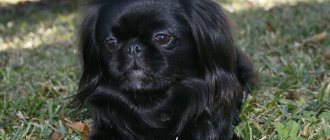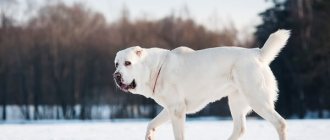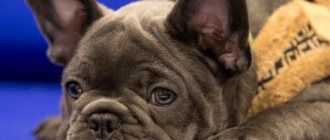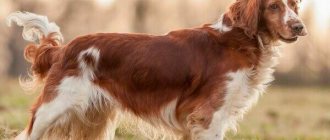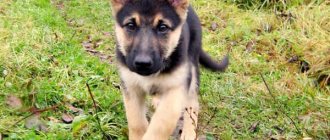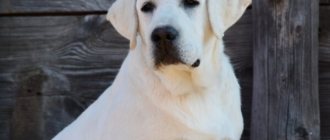Spaniels are a large group of breeds that are primarily hunting dogs, but also include toy and toy dogs.
Among them, the most popular are Cocker Spaniels, Russian Spaniels, Cavalier King Charles Spaniels, Continental Toy Spaniels and others.
The German Wachtelhund, also called the German Spaniel or the German Quail Dog, is a medium-sized hunting dog that can not only find, fly and bring game birds to the hunter, but is also an excellent blood trail follower.
It is strong and resilient enough to hold wounded ungulates in place until its owner approaches.
An excellent hunting assistant and reliable companion, the Wachtelhund is distinguished by its exceptional devotion to its owners.
However, despite all its wonderful qualities, it is little popular outside of Germany and is considered rare almost throughout the world.
Origin story and what it looks like in the photo
In the mid-19th century, English gun breed dogs were used for hunting in Germany . But they turned out to be not very good helpers for German hunters, since they could not work both in open areas and in dense forests at the same time.
In addition, due to their narrow specialization, English cops did not know how to work both with a pen and with an animal, and also did not raise their voices while working.
German hunters needed a dog that could successfully track game in a variety of conditions: in the field, forest, on rough terrain, in the mountains.
It was also very important that the dog could work at any time of the year and would not refuse to go into the water for shot game..
To obtain a breed that best met these requirements, the German breeder Frederick Robert began crossing the German Stöberer with various spaniels of English origin in the 1890s.
Initially, it was believed that only black dogs could work independently, while brown dogs, according to hunters of the late 19th and early 20th centuries, were too dependent on the owner.
Modern Wachtelhunds can all work either walking next to the hunter and following his instructions, or completely independently..
Official recognition of the new breed occurred in 1903, and at the same time a national breed club was created in Germany. And in 1910, eleven dogs were selected throughout the country that best met the requirements of the standard.
It is from these dogs, considered ideal in appearance and working qualities, that all modern Wachtelhunds originate.
In the 1960s and 70s, several German Wachtelhunds were brought to the United States, where they proved to be excellent hunters, even targeting American black bears..
But at the same time, German spaniels received official recognition in this country only in 1996.
Characteristics of the Wachtelhund breed
The Wachtelhund is a versatile hunting dog. It helps to hunt birds and animals, works equally well in the field, forest, swamp, and swims well. She has an innate ability to search for game by following the trail, as well as to fetch. The Wachtelhund hunts quail best, which is why it is also called the “quail dog.” The name is translated like this: wachtel - quail, hund - dog.
German Wachtelhunds are spaniels and are similar in appearance and habits. But they are more massive, hardy and efficient. This is not only a hunting dog, but also a devoted, obedient companion.
| Options | Characteristic |
| breed name | German Wachtelhund |
| a country | Germany |
| group of breeds according to the ICF classification | retrievers, spaniels and water dogs |
| application | hunter, bloodhound, companion |
| life expectancy | 11-13 years old |
| height | males 48-54 cm, females 45-52 cm |
| weight | males 20-25 kg, females 18-23 kg |
pros
Wachtelhunds are calm, obedient dogs. They have many advantages:
- This is a universal hunting dog;
- unpretentious, hardy, work in any weather conditions;
- have a calm, friendly character;
- sociable, loyal, but not intrusive;
- smart, easy to train;
- love children and are patient with them;
- with sufficient physical activity at home they behave quietly and unnoticed;
- have good health.
Minuses
The German Wachtelhund is not suitable for keeping in a city apartment. He cannot become an ordinary house dog. This is a very active dog, it requires an active owner and special training. Before getting a dog of this breed, you need to know about its disadvantages:
- needs high physical activity;
- her pronounced hunting instinct does not allow her to be kept with small pets;
- on the street they chase birds and cats.
Description of the breed
The German Wachtelhund is a muscular and robust hunting dog of medium height with fairly long, thick, wavy hair. However, some dogs of this breed have straight and smooth hair.
Externally, representatives of this breed are slightly reminiscent of English springer spaniels, as well as Russian hunting cocker spaniels, but taller than them and somewhat more massive.
Wachtelhunds are famous in Germany as skillful and dexterous hunters, working both with feathers and with animals, but they are rarely kept as pets.
German Spaniels cannot do without the work for which they were once bred . Therefore, breeders extremely rarely sell puppies to people who are not keen on hunting.
Before starting to use a dog for hunting, German hunters and their pets pass special exams, which include checking the work on the scent of a hare, the absence of fear of water and fear of being shot.
Personality of German Spaniels
Wachtelhunds are intelligent, loyal dogs. They have no aggression, they are obedient and people-oriented. These are friendly, sociable, playful pets. They love to spend time with children, treat them patiently, and protect them. These dogs have a balanced character; they are not prone to aggression or nervous breakdowns. They treat strangers warmly and wag their tail happily.
These dogs are hardy, efficient, passionate, and have innate hunting qualities. The desire to track down and catch up with small animals cannot be eliminated by training, so it is recommended not to let your pet off the leash on the street. Wachtelhunds easily catch pigeons and cats. For the same reason, representatives of this breed do not get along in the house with pets other than dogs.
In the description of the German spaniel, the following character qualities can be distinguished:
- calm;
- friendly;
- devotees;
- obedient;
- sociable;
- smart;
- hardy;
- touchy.
In addition to hunting, representatives of the breed can be used for dog sports. They are persistent, dexterous, persistent in achieving their goals, and therefore achieve good results.
Training
The German Wachtelhund is an intelligent, quick-witted and inquisitive dog. He remembers commands easily and loves to learn new things. Submits only to a person with a strong-willed, strong character who can gain authority from him.
It is necessary to raise a dog from the first days of its appearance in the house. Although with the right approach it is easy to re-educate her at any age. But it is better to immediately show a small puppy the rules of behavior. He must respond to his name, know his place, and walk calmly on a leash. The first commands are “no”, “near”, “sit”, “stand”. These dogs love to look for various objects and fetch.
When training, you should follow the advice of dog handlers:
- training should be regular and consistent;
- It is not recommended to raise your voice, these dogs are touchy, you can lose your pet’s trust;
- watchmen need motivation to carry out a command, a treat is best, but affection can be used.
To be used for hunting, dogs pass a test at 18 months. The ability to follow the trail and the ability to swim are tested. The dog should not be afraid of shots or water.
Character traits
German spaniels are calm and friendly, they are trusting of their owners and, with proper training, can be quite obedient.
These dogs are not prone to nervous breakdowns or sudden attacks of aggression . True, they may bark at the sight of strangers, but usually because they are glad to see them and thus express their joy in meeting them.
Wachtelhunds are good-natured and sociable; they treat all their owners equally well, regardless of their age.
At the same time, they have enough strength and courage to hunt even large game, they do not hesitate to go into the water to feed the shot game, and, if necessary, they can hold even a wild boar in place until the hunter arrives.
Wachtelhunds are considered smart and quick-witted dogs, they easily learn new skills, but only if the method of encouragement is used in their training.
If you show rudeness in handling a German spaniel or undeservedly offend the pet, the dog may even refuse to hunt with its owner..
Expert opinion
Kozhevin Semyon Kirillovich
Expert dog handler.
“The German Wachtelhund, little known outside of Germany, is an excellent hunting dog that works equally well on both birds and animals. This dog, without much thought, goes into the water after shot game and does not refuse to work on the blood trail. At home, the Wachtelhund behaves calmly and balanced: he is friendly towards people, even strangers, and gets along well with all family members. However, it is not recommended to have such a dog as a pet, since Wachtelhunds are bored without work, and their unrealized hunting instinct will force them to chase birds, cats and other small animals while walking.”
History of the origin of the breed
The Wachtelhund breed was bred in the 19th century in Germany. Then ordinary people were allowed to hunt. Those who could not maintain a kennel tried to have a universal assistant who could replace several dogs. The dog had to perform the duties of a cop, a bloodhound, be able to swim, and work in any weather conditions.
To do this, breeders crossed Steberers with different types of spaniels. The breed was called the German Wachtelhund. The dogs turned out to be balanced, fast, hardy and obedient. They could follow a blood trail, lift a bird on its wing, and bring back killed game. They are even capable of tracking down and holding wounded foxes, hares, and ungulates. With proper training, they work independently.
The official standard for this breed was approved only in 1981. These are working dogs that find it difficult to live in confined spaces. Therefore, the breed is now quite rare, known mainly in its homeland. In Germany, only professional hunters with a license are allowed to own Wachtelhunds.
Advantages and disadvantages
pros:
- A universal hunting dog that works on both birds and animals, including large ungulates.
- Can hunt at any time of the year and in a wide variety of conditions - in the forest, field, in wetlands, in the mountains.
- It easily learns to work with a new type of game, for example, in the USA and Canada, Wachtelhunds are used to hunt baribal bears.
- Bold, courageous and vicious towards potential prey during the hunt.
- Friendly and calm attitude towards people.
- They are sociable and get along with all family members, including small children.
- Smart and well trained.
- They can adapt to any conditions and are quite unpretentious.
- Unobtrusive: they don’t like to get under their owners’ feet.
Minuses:
- They are not suitable as ordinary companions, as they cannot do without hunting.
- They need quite a lot of physical activity and long walks.
- They feel best in rural areas.
- They can be aggressive towards small animals.
- Does not tolerate rude treatment and undeserved insults.
- A rare breed, which is why it is not always easy to find a suitable puppy.
Description
Translated from German, the name Wachtelhund means quail dog. Although representatives of the breed scare away feathered and land game and bring in wounded animals, the spaniel works with particular passion for quail. The appearance of the animal fully corresponds to the specialization of the breed: a compact body in the shape of a rectangle, strong paws, a small movable tail - an excellent balancer. The German Spaniel breed standard prescribes a male weight of 25-28 kg with a height at the withers of 50-52 cm. The dimensions of the female are more modest: weight 18-20 kg, height 45-48 cm.
The head of the representative of the German Wachtelhund breed is elongated, with a sloping large forehead. The ears are medium length, hanging, set high. The legs are low in relation to the body. The body shape is a lying rectangle. When working in fields and forests, a dog with such a body and legs can easily maintain balance in pursuit of a fast-moving hare or fox. The animal's coat is medium length, silky, without thick undercoat. Once wet in water, it dries quickly. The color is brown and red with a red tint. White spots are allowed on the face, toes, and belly.
Character
The Wachtelhund has a friendly character and is completely devoid of aggression towards humans. The dog is smart, devoted to its owner, and ardent in its work.
The German Spaniel has a strong hunting instinct towards small animals and birds. This behavior cannot be corrected by training. The Wachtelhund cannot be recommended for keeping in a house that already has cats, parrots, guinea pigs, or hamsters.
Representatives of the breed are successfully used for hunting and sports. Passion, perseverance and tenacity in tracking down game are the main characteristics of the German Wachtelhund. An innate sensitive sense of smell and good “voice work” allow you to hunt with a dog in the forest, in swamps, and in the snow in winter. The spaniel without hesitation goes into the water and brings back the shot bird.
Training
Raising a dog begins from the first hours of the puppy's appearance in the house. The child is set the limits of acceptable behavior in the family. The German Spaniel has a lively mind and is able to easily learn new commands. However, he has a strong character and will only listen to one person with a strong leadership character.
Breed standard
- Head . Proportional to the body, slightly flattened in the skull, with a not too sharp transition to the muzzle.
- Muzzle . Of medium length, tapering only slightly towards the tip of the nose, it looks almost rectangular from the front.
- Ears . Set approximately at eye level, quite long: the tip of the extended ear should reach the nose.
- Eyes . Small, slightly slanted, with an expressive and calm look.
- Neck . Strong and muscular.
- Rib cage . Round in shape, with slightly curved ribs.
- Belly . Moderately tucked, not forming a strong bend.
- Forelegs . Parallel, quite strong and even.
- Hind limbs . Strong, with muscular thighs and well defined joint angles.
- Tail . Thick at the base and strong, not rising above the line of the back.
- Wool . Thick, wavy, close-lying with well-developed undercoat. It is short on the head, muzzle and front side of the legs, medium length on the body, and has small feathering on the ears, lower part of the tail and back of the limbs.
Among hunters, it is traditional to dock the tails of German Wachtelhunds by about 1/3 of the length, as this makes it easier for the dog to work in the thickets of the forest and reduces the risk of injury.
Color variations
The most typical color for German Spaniels is brown or reddish, often with small white markings on the chest and toes..
A brown or red-mottled coat color is also acceptable for them. In addition, there are white dogs with brown spots or brown spots.
NOTE!
The black color is currently considered non-standard and is not found in purebred Wachtelhunds.
Any standard color may have a tan.
Brief historical background
A breed of dog is known from hunting literature, similar in appearance to the modern German Wachtelhund, which several centuries ago was used primarily for searching and lifting game in wooded areas. The name of the breed - “Wachtelhund”, or “quail dog” - is also found in historical documents. The breed developed in its current form at the turn of the 19th-20th centuries. The ancestor of modern Wachtelhunds was “Lord Augusta 1834L” from Staufenberg (Upper Bavaria). Breeding began with the mating of this male with several females of the same type. At first, only dogs of brown color (sometimes with white markings) and brown-white were allowed for breeding; later, dogs with small red markings on the head and limbs, the so-called “tan,” were included in breeding.
The ancestor of brown-piebald dogs was the female “Baby auf der Schanze 1838 L”. Rudolf Frieb, who has been involved in intensive breeding work with the breed for decades, introduced a division within the breed according to brown and brown-piebald colors. He also managed, despite the small initial base, to avoid degeneration of the breed due to inbreeding by targeted matings within both colors. The division by color was due, among other things, to the different inclinations of the dogs. Brown dogs worked in contact with the hunter, on a narrow search. Brown piebalds were more independent and, having good instincts, were more suitable for tracking work.
Currently, these differences in work are no longer characteristic of both colors, since for various reasons matings occurred between dogs of different colors. However, division by color is still used to maintain separate lines within the breed. The German Wachtelhund was bred and bred by hunters for hunters, and is a game-raising dog and a versatile hunting dog.
Is he good with children and does he get along with other pets?
The German Wachtelhund gets along well with children, even the smallest ones, and willingly plays outdoor games with older ones.
German spaniels are quite friendly towards other dogs and rarely conflict with them..
But at the same time, German spaniels do not tolerate the presence of smaller animals - cats, ferrets, rodents and birds.
Due to their highly developed hunting instincts, Wachtelhunds will regard such pets as their potential prey and may hunt them.
The situation with the breed in the Russian Federation
In Russia, targeted work with the breed has been carried out for the last several years, and very successfully. Let us note that the Wachtelhund is not so much a sporting breed as a “workhorse”. And at the moment, all dogs in Russia are exclusively in the hands of hunters. In 2012, the number of Wachtelhunds in Russia reached 38 dogs. Most of them are concentrated in the central regions (Moscow, Kaluga, Tula, Nizhny Novgorod regions), but several representatives of the breed are found both on the southern and northern borders, and even in Siberia and the Far East. In all regions, Wachtelhunds have proven themselves suitable for local hunting; they work well on almost all types of game, in any weather conditions, in any area with different landscapes and vegetation. However, the most friendly and attractive areas and conditions that allow dogs to reveal the maximum breed qualities are the central part of Russia and the harsh northern and taiga areas. There the Wachtelhund feels “at ease”. Work on quail, corncrake, partridge, black grouse, woodcock, wood grouse, duck and goose, coupled with periodic meetings with hare, fox and ungulates, allows him to reveal himself to the maximum and feel his breed purpose.
In the northern regions, the Wachtelhund feels great, incl. and in winter. A well-developed undercoat, relatively tall growth and other features allow it to work in fairly harsh weather conditions: low temperatures, in cold water, in “large” snow. Dogs also performed well in areas with “big water” and swamps. A natural passion for water allows them to work tirelessly in bodies of water for hours in search of game. In the southern regions, Wachtelhunds were tested on pheasant, quail and hare hunts. In a fairly short time, dogs manage to adapt to hot weather conditions. By about a year and a half, dogs reach sufficient hunting maturity and gain some experience to pass tests. Today, Wachtelhunds in Russia are tested only according to the rules for spaniels, namely “Rules for testing spaniels for field, swamp-meadow and upland game” and “Rules for testing spaniels for duck”.
In remote regions, due to the small number of specialized events for spaniels, Wachtelhunds take part in interbreed waterfowl competitions, according to the relevant rules. The fact that Wachtelhunds are tested in our country according to the general rules for spaniels has both pros and cons. On the one hand, this does not quite correspond to the principle of breeding abroad, where the main tests for Wachtelhunds are complex tests, which include both a blood trail and work on the hooves. In our country, these types of tests for spaniels have been abolished, and work is now underway to obtain permission to test these types specifically for Wachtelhunds.
On the other hand, the fact that we only have feather tests for spaniels allows us at this stage to develop the breed in accordance with its original purpose, i.e. like a bird dog. Some owners successfully use dogs in hunting animals (in driven hunts, as well as in collecting wounded animals). Note that working on the same wild boar differs from the work of huskies; dogs prefer not to grab, but to work at a distance of 3-4 m, “circling” the animal, remaining out of reach of it. But bird hunting should still remain paramount for this breed - unlike Europe, Russian conditions allow this in full. Although the breed is quite young for our country, the dog population in the Russian Federation has made some progress. To date, 2 generations of Russian-bred dogs have already grown up.
Both the imported dogs and their descendants showed high field qualities, confidently show a good sense of smell, are sociable and persistent in work. By participating in field events, dogs receive field diplomas, including second and first degrees, which has allowed them to enter the breed team into competitions of quite high status in the last two years. Thus, at the Moscow regional interbreed competitions of spaniels the Wachtel-Club team took 2nd place, at the All-Russian duck competitions 2011 in Cherepovets - 3rd place in the individual competition, and at the All-Russian field, marsh-meadow spaniel competitions game in Solotch in 2012 – 2nd place in the team competition and 2nd place in the individual competition.
GREENLAND DOG: HISTORY OF THE BREED AND CHARACTER OF THE DOG
BOXER DOG: HISTORY OF THE BREED AND CHARACTER OF THE DOG
ST BERNARD: HISTORY OF THE BREED AND CHARACTER OF THE DOG
Dwarf Pinscher: HISTORY OF THE ORIGIN OF THE BREED AND CHARACTER OF THE DOG
How to properly care
The German Spaniel's coat should be brushed approximately once a week and washed as needed using dog shampoo.
It is recommended to inspect the ears and eyes every day and clean them if dirty . Teeth should be brushed periodically, about twice a month, with a toothbrush and toothpaste intended for dogs.
Nails are trimmed as they grow, but care must be taken not to injure the pet during this procedure.
It is advisable to periodically trim the hair between the toes and paw pads, as otherwise it will collect dirt, and in winter ice will freeze on it, causing discomfort and even pain to the pet..
How long do they live? Health and major diseases
German Wachtelhunds live from 12 to 15 years.
The breed is generally considered to be quite prosperous and healthy, however, some of its representatives may be predisposed to the following health problems:
- Skin diseases such as dermatitis or eczema.
- Oral diseases that are more common in animals with malocclusions.
- Dysplasia. Retinal atrophy.
- Eversion and inversion of the eyelids.
- Hypothyroidism.
- Allergies.
- Melanoma.
- Degeneration of intervertebral discs.
- Epilepsy.
Health problems
The German Wachtelhund has high immunity. Puppies are almost always born strong and healthy. The average life expectancy of these dogs is 12-15 years if the animal is kept in good conditions and has constant physical activity.
Some representatives of the breed are prone to the following diseases:
- skin problems;
- if a dog has an incorrect bite, dental problems are likely to occur;
- eye diseases - problems with the retina or cataracts, which can only be treated surgically;
- Sometimes dogs have allergies;
- diseases of the spine in the form of a herniated disc, to which these dogs have a genetic tendency;
- Melanoma and epilepsy are very rare.
To avoid health problems for your pet, veterinarians recommend that you follow all necessary measures: medical examinations, vaccinations, and treatments for parasites.
Nutritional features - what is best to feed?
Like all hunting dogs, the German Wachtelhund needs nutritious, complete food rich in protein.
With natural feeding, approximately 2/3 of the diet should be lean muscle meat and offal with the exception of bones, kidneys and raw liver.
To them you should add a little porridge made from oatmeal, rice or buckwheat, as well as boiled or raw vegetables. Fermented milk products - cottage cheese, kefir and natural low-fat yogurt - are useful, especially for growing puppies.
Once a week, it is recommended to replace meat with boiled sea fish without bones, and you should give one and a half times more fish than meat..
The German Spaniel is also suitable for feeding with a premium quality complete food or higher. It is very important to choose the right brand according to the size, age and physical condition of the pet.
For a dog suffering from a disease that requires food restrictions, special dietary foods are best suited.
Care and maintenance
The German Spaniel is an active and energetic animal. It will be difficult for him in a small apartment. If the owner can provide active walks with outdoor games and activities 2-3 times a day, the spaniel will be comfortable. Outside the city, in a private house with a spacious yard and the opportunity for the dog to run through fields and meadows, the Wachtelhund will live a happy life. The main thing for the dog owner is to remember about the hunting abilities of the pet, avoiding damage to village birds and small animals.
Caring for a pet is not difficult. It consists of weekly combing of the dog's coat and bathing the dog once every 2-3 months. It is necessary to clean the spaniel's ears and trim his nails. Particular attention should be paid to the hair growing on the paws between the toes. In winter, pellets of snow stick to long hair, making it difficult and painful for the dog to walk. The coat needs to be trimmed short.
Feeding
The basis of a dog's diet should be meat, lean and sinewy. Beef, goat, horse meat, rabbit, chicken are good. Up to half of the daily dose, meat can be replaced with offal: lungs with trachea, heart, liver, tripe, tails and ears of livestock. Dogs are given bones not as food, but to satisfy the need to chew.
Tubular and bird bones should not be given to dogs! When chewed, sharp fragments can damage the stomach.
It is useful to give spaniels low-fat cottage cheese and kefir; fermented milk products have a beneficial effect on the stomach and strengthen the immune system. About a third of your pet’s daily diet comes from cereals and vegetables. Thick porridge from buckwheat, rice or oatmeal is cooked for the animal. At the end of cooking, add carrots, pumpkin, beets or zucchini cut into pieces into the porridge. It is useful to add a chicken or quail egg, one per week, and unrefined vegetable oil. Fruits will be a good treat for your pet: apple, pear, melon, watermelon. Food from the human table is not suitable for dogs. You should not give spicy, smoked, salty food, baked goods, fish with bones, or sweets.
Modern owners have a great alternative to cooking their dog's food at home. These are ready-made dry food. They contain all the necessary nutrients, vitamins and minerals. A line of food has been developed for dogs of any age and physiological condition. For a puppy, dry food granules are soaked in warm water. An adult pet can be given dry food. Water should be freely available to your pet.
Diseases of the German Wachtelhund
The spaniel is considered a hardy dog with good health. The life expectancy of representatives of this breed is about 13 years. Dogs can suffer from otitis media and conjunctivitis, allergies. Due to the structural features of the body, intestinal volvulus may develop against the background of high mobility. To avoid this, you need to feed your pet only after a walk.
How to choose?
In order for a puppy to grow into a typical representative of its breed and become a good hunting assistant, you need not to rush into acquiring it, but to approach the choice of your future pet responsibly.
CAREFULLY!
It is not recommended to buy a German spaniel without documents, since there is no guarantee that the purchased baby will not be a mixed breed or will not suffer from any disease.
When choosing a puppy, you need to take into account that males are more active and look more impressive in appearance, but at the same time they can be more stubborn than females.
Female Wachtelhunds are more obedient and good-natured, they get along better with children, but you cannot hunt with them during heat, which may not be very convenient.
A purebred German spaniel puppy looks quite strong and well-fed, it has fairly thick paws, a rectangular muzzle and elongated wide ears covered with silky wavy hair.
The baby’s gaze should be friendly, calm and attentive, and both cowardice and aggression are completely unacceptable in his behavior.
Price
It is advisable to purchase puppies only from breeders who are members of the Vakhtel Club. The price of dogs ranges from 20,000 to 28,000 rubles. Purebred representatives of the breed must meet all its standards, and during the purchase, potential owners undergo a kind of casting in order to be able to buy such a dog. Dogs purchased through VakhtelClub have all the necessary documents and vaccinations.
It is not recommended to buy puppies that are sold on trading platforms. Although a dog without documents can be purchased much cheaper, there is no guarantee of its purebred origin. Dogs registered in other communities are usually not controlled, therefore no one is responsible for the quality of the breed.
Main nurseries in Russia and the CIS
In Russia, it is recommended to purchase a dog of this breed through the National Breed Club “German Wachtelhund”, which is located in Moscow.
In Ukraine, you can buy a German spaniel in the MASTER HUNTING kennel in Kirovograd.
Data on these organizations can be found on the Internet or on their websites.
